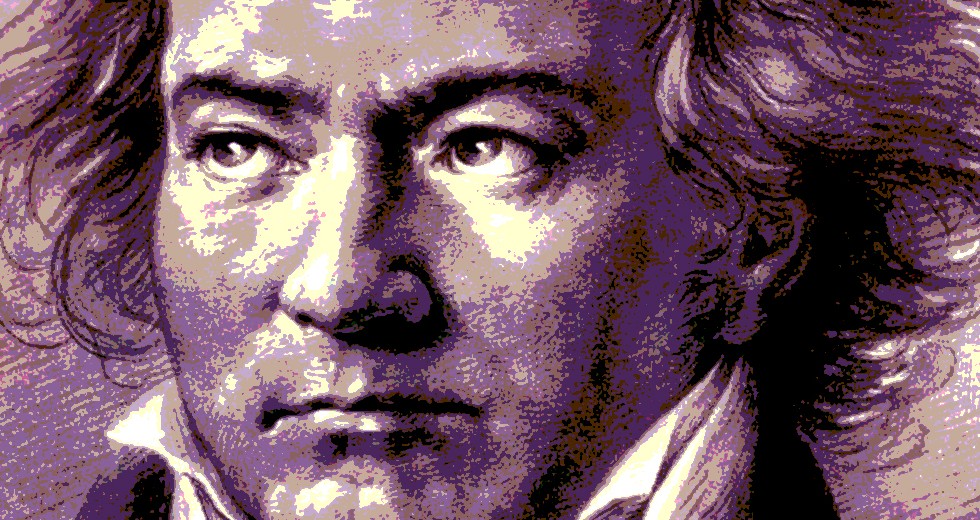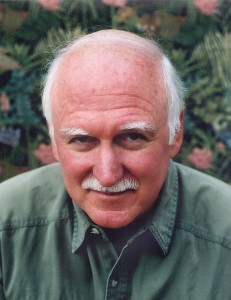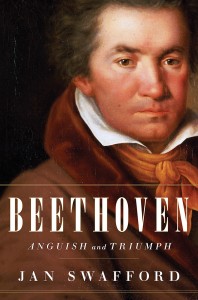
After writing well-received biographies of Charles Ives and Johannes Brahms, Jan Swafford took on the challenge more than a decade ago of chronicling the vast life and work of Ludwig van Beethoven. In his recently published 1,077-page book titled Beethoven: Anguish and Triumph (Houghton Mifflin Harcourt), the Boston-based composer, journalist and music historian tried to uncover the still-elusive man behind the celebrated music. In this Q&A interview, Swafford discusses the biography and shares some of his conclusions about Beethoven and his musical accomplishments, including the Symphony No. 9 and Missa Solemnis.
Q. Scores of books have been written about Beethoven. Why did you decide that there needed to be another biography?
A. Some of the reasons were practical. Somebody asked me to write it, and I was resistant. When it started coming together, I felt that the writings about Beethoven for the last 30 or 40 years had been dominated by the academic industry. And some of those books are fine books, but those books were more ideas about Beethoven than about Beethoven himself. My own favorite book about understanding the man and his life was still Thayer in the 19th century [Alexander Wheelock Thayer’s Life of Beethoven, originally published in 1866-79]. There were some books in the earlier ‘20s that were too romantic for me. In other words, there was never a Beethoven book that I felt since Thayer that really laid out the man well, and I think Thayer, at the same time, is a very 19th-century book. It’s quite 19th-century in its language. So I wanted to do something like Thayer, which I don’t think anybody else has done as such, but that also had a lot to do with the music, because I had a lot to say about it.
Q. How long did the research and the writing take?
A. About 10 to 12 years. The example that I use is that when I wrote a biography of Charles Ives, I had about 1½ bookshelves of material on Ives. With Brahms, about 2½. With Beethoven, it was the better part of two bookcases. There is an enormous amount of writing about Beethoven, and then I went to Bonn and found quite a lot in German that had never been used before in English. It took many, many years to wade through all that and digest it.
Q. What else was different about writing the Beethoven book than the other musical biographies that you’d done?
A. In terms of the writing, it was partly just practical. You want to get a good flow in the writing, but so many sources were bearing on each page of the Beethoven — sometimes eight or 10 footnotes or more per page — and it was terribly, terribly slow. And I would just sit there and over the course of a day and not be able to get more than a page or two drafted, and the Ives and Brahms were just not like that. I didn’t have all that enormous weight of research material sitting on top of me. I’ll say one other thing about the writing: The writing on Beethoven had tended to be kind of dry and academic on one side, especially the biographies of the earlier part of the 20th century, and kind of goopy on the other side and moony by my standards. And I wanted to do something that was neither dry nor moony. And since that’s a pretty vague attitude, finding a style that reflects what you mean by that is not so easy.
Q. As you researched and wrote the book, what was the biggest surprise?
A. There were any number of small surprises. There was no grand surprise. [What] struck me the most is that [during] the last couple of years of his life, just how heartbreakingly sick and in pain he was. When he was writing the C-Sharp Minor Quartet [String Quartet No. 14 in C-Sharp Minor, Op. 131), which is about as sublime as a piece of music gets, he was dying of liver disease and he had to wear basically a corset to hold his guts together, because his body was filling with water. His ability to put aside physical pain and illness and be in the places he was in the late music — I can’t say it surprised me but I hadn’t realized how bad it was and I was just in awe of him by the end.
Q. Any other revelations?
A. When I really started looking at the sketches and looking at the background of some pieces, especially the Eroica [Symphony No. 3 in E-Flat Major, Op. 55], they just began fill in ways that I hadn’t expected and didn’t realize. And you begin to realize how the totality of his music makes patterns. I was very curious about the influence of the Freemasons and the Illuminati in Bonn. What I didn’t know was that his teacher [Christian Gottlob] Neefe was head of the Illuminati lodge in Bonn. And I didn’t know that he already planned to set Ode to Joy when he was a teenager and to what extent Ode to Joy was really a document of the revolutionary 1780s and how the things he learned in Bonn and absorbed in Bonn played out for rest of his life all the way through the Third Symphony to the Fifth Symphony and finally, to the Ninth Symphony. That’s one arc of thought and development.
Q. What’s the most misunderstood aspect of Beethoven’s life?
A. That he is some kind of a god or demi-god or the one guy [whose name is] over the proscenium in Boston Symphony Hall, and he is the answer to all music and the greatest of all composers and something superhuman and so forth and so on. [I believe] Beethoven was a guy like everybody else who happened to have been born with an enormous talent and had incredible discipline and good training and enormous encouragement. He was told at age 10 that he was the next Mozart and he never doubted that. Just to what extent nonetheless he was simply a human being who had extraordinary powers like some human beings do?
Q. Which work gave him the voice that we know as Beethoven’s?
A. That’s a very interesting question, because I came to some conclusions about that having to do with the first, second and third periods [of his compositional timeline]. This is an old division of his work, and I didn’t basically challenge that. I think it makes some sense. But the first period most people tend to think of as him looking for his voice and learning his craft and getting his ideas together. I remember when I first studied the Op. 18 quartets, which to us don’t sound very Beethovenian, and they sound very 18th century. I realized that they were marvelous pieces of craftsmanship, and there was nothing searching in them at all. And then I remembered that the Pathetique Piano Sonata [No. 8 in C Minor], which was Op. 13, written earlier than the quartets were published, we tend to think of as high Beethovenian. So the search for his voice is not what we tend to think it is. What we call the Beethovenian voice he sort of had here and there from the beginning, but obviously, he didn’t think of it that way.
One of things I realized is that it depended in what genre he was writing. When he got a commission for string quartets, he knew he was up against Haydn, so he was very cautious. But in his piano music, he was very bold, because he felt he was writing the first great body of piano music. He was part of the first generation of pure pianists, and that’s very important to his piano music. So the second period is not something that happened at once. It was something that was already part of him that he consolidated into at a certain point and he said this is who I am and I’m going to concentrate of this part of myself, which we call Beethovenian. So the first period, he is bold in some respects and he’s cautious in others. He’s experimenting with voices but he is already a master. There is no apprentice work anywhere in his opus numbers. You can say this or that work is weak or this or that doesn’t work as well as something later, but he did not publish apprentice pieces. That was already behind him when he started publishing by Op. 1.
Q. What’s the most puzzling of his musical works?
A. The same one that everyone else [cites] — the Grosse Fuge [Op. 133], the last movement of the late B flat quartet, which his publisher persuaded him to spin off into a separate piece. It’s a madhouse. It really is — this gigantic, crazed, relentless fugue that goes on fortissimo for page after page. Certainly, it’s the most modern piece he ever wrote, but I don’t really know what it is doing and why exactly. I do technically, but emotionally and expressively, I don’t know really what it is doing. On the other hand, I think that’s the real finale for the quartet. The replacement doesn’t make it for me. That’s the one, like a lot of other people, I scratch my head over the most.
Q. Do you have a favorite Beethoven piece?
A. I can’t really say that, but the one I kind of perennially champion is the Missa Solemnis, which is his most difficult large piece. It’s never been as popular as his symphonies. It’s tremendously hard to put on. It’s hard to sing. It’s hard to assemble. It’s hard to listen to, because it doesn’t fall into standard symphonic forms. And yet, Beethoven thought it was his greatest work, and so do I. I don’t think it’s perfect, but I think it an astounding achievement. It’s on the order of the Wagner operas and things like that, but it also happens to be Beethoven, who had some kinds of control that Wagner didn’t — maybe.
Q. You write that Beethoven’s Ninth attained the place in the world that he intended. Could you elaborate?
A. That’s not something he said, but on the other hand, Beethoven didn’t like to talk about music very much, especially his own music. So he didn’t say what his intentions were with the Ninth Symphony. And just like the Missa Solemnis is not only a mass that would be presented in a service — the idea of doing sacred works outside of church was really quite new in those days — the Ninth Symphony was something that really kind of exploded the concert hall. It reached out of the concert hall. And this is nothing new: I think he intended the Ninth Symphony finale theme to be a kind of human anthem in the tradition of “God Save the King” in England and Haydn’s Austrian anthem. And that the whole piece was outsized and ceremonial and very much related to the large ceremonial works of the French Revolution that he had known from his youth. These are great ceremonial pieces raising big ideas. I think also that in a time of tremendous repression, a police state in Austria, everybody knew that the Schiller poem [Ode to Joy] was a revolutionary poem from the 1780s. Beethoven wrote the Ninth in part as a grand ceremonial work, an anthem for humanity to keep the idea of freedom alive, and the ideal society, in a time of terrible repression.
Q. And it’s come to be a piece that we play at all sorts of pivotal historical moments.
A. I used to resent that. I thought it was such a cliché — that every time something big happened people trot out the Ninth Symphony. But now I think that it was it was for. That’s what it was written for.
Q. Are you working on another biography? Is there another composer on the horizon?
A. I’m starting work on a Mozart biography. For similar reasons, that the ones [biographies] out there, some of which are quite good, still don’t satisfy me and still are not as close to him as I would like to see. He was such a fascinating character, so different than any of my other subjects.
Kyle MacMillan, former classical music critic of the Denver Post, is a Chicago-based arts writer.
NOTE: To hear excerpts from some of Swafford’s musical compositions, click on the audio links below.

